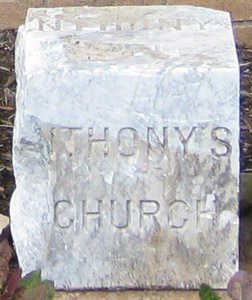
News & announcements
Saving your history
Early accounts
Maps
Nearby towns
People
Churches
Schools
Municipal
Organizations
Businesses
The mines
Transportation
Streets
Buildings
Entertainment
Celebrations
Sports
Ethnic groups
St. Anthony's Roman Catholic Church
What's on this page:
- Founding of St. Anthony’s Church
- 1901, 1921, 1940, 1967 renovations and rebuilding
- 1902 Baptismal certificate for Ida Raffaela Adeline Moretti from St. Anthony’s
- Men and boys in front of the church - Sons of Italy
- Lithuanians joining St. Anthony's
- Closing and joining the Freeland Roman Catholic Community
On related pages:
Founding of St. Anthony's Church
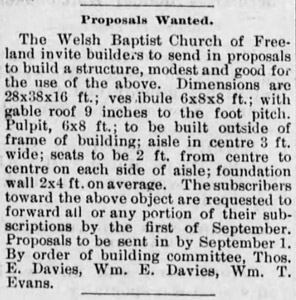
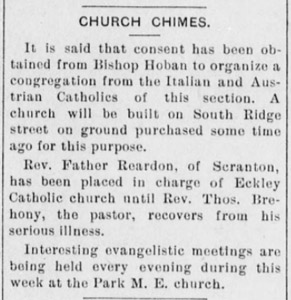 The
original church building was built in 1892 for the Zion Welsh
Baptist Church. The Bethel Baptist Church on Ridge and Walnut
was also
built around that time, and services were conducted mostly in Welsh at
Zion
and in
English at Bethel. The article at left from the Freeland Tribune
8/25/1892 advertised for proposals from contractors to build a church,
and it gives the planned dimensions of the building. Local contractor
Lewis H. Lentz won the contract. A few years later, the article at
right from 10/19/1899 notes that Italian and Austrian immigrants had
received permission from the Scranton diocese to found a new church.
The
men who applied to the Bishop in Scranton for creation of a new church
were Frank and Salvadore DePierro, John
(Battista) Yannes, Peter Magagna, Vincenzo DaGrosa, John Ferdinand and
Leonard Branz.
The
original church building was built in 1892 for the Zion Welsh
Baptist Church. The Bethel Baptist Church on Ridge and Walnut
was also
built around that time, and services were conducted mostly in Welsh at
Zion
and in
English at Bethel. The article at left from the Freeland Tribune
8/25/1892 advertised for proposals from contractors to build a church,
and it gives the planned dimensions of the building. Local contractor
Lewis H. Lentz won the contract. A few years later, the article at
right from 10/19/1899 notes that Italian and Austrian immigrants had
received permission from the Scranton diocese to found a new church.
The
men who applied to the Bishop in Scranton for creation of a new church
were Frank and Salvadore DePierro, John
(Battista) Yannes, Peter Magagna, Vincenzo DaGrosa, John Ferdinand and
Leonard Branz. So in 1899 the founders of St. Anthony’s congregation were looking for a place to build a church. They originally bought land in the 400 block of Ridge Street, next to the school building that later became Belekanich’s. At present it's not known what led them to change course and explore the purchase of the Zion church.
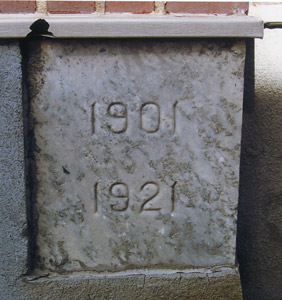
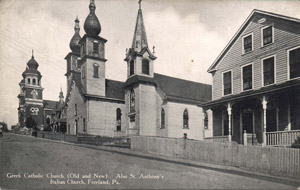 The Zion
church closed less than 10 years after opening and was bought by
St.
Anthony's congregation, blessed for its new use and opened in
1901.
This
postcard shows St. Anthony's and the old and new St. Mary's church
buildings around the first decade of the 20th century. It might be the
earliest photo of St. Anthony's (formerly Zion Welsh Baptist) that I've
seen. The cornerstone shown at right may have been made during the 1921
renovations to the building. The location of the 1892 Zion cornerstone
is unknown at present.
The Zion
church closed less than 10 years after opening and was bought by
St.
Anthony's congregation, blessed for its new use and opened in
1901.
This
postcard shows St. Anthony's and the old and new St. Mary's church
buildings around the first decade of the 20th century. It might be the
earliest photo of St. Anthony's (formerly Zion Welsh Baptist) that I've
seen. The cornerstone shown at right may have been made during the 1921
renovations to the building. The location of the 1892 Zion cornerstone
is unknown at present.St. Anthony’s Diamond Anniversary booklet (75 years) lists these early members (p. 9) from northern and southern Italy and Austria-Hungary (including the Tyrol):
From Calabria: Pignatari, Poleri, Valeo, Citro
From Roseto: Positano
From Sicily: LaPorte
From Calvello: Bellezza
From Castellucci: Contini
From Naples: Pappalardo
From Salerno: Lut, Vitagliano
And from the Trentino/Tyrol:
From Castelfondo: Yannes, Bartol, Marchetti
From Salobbi: Corazza
From Sanzeno: Branz
From Fondo: Lorenzetti
From Revo: Clauser, Magagna, Ravina
From Solandra: Ceriani and Maso
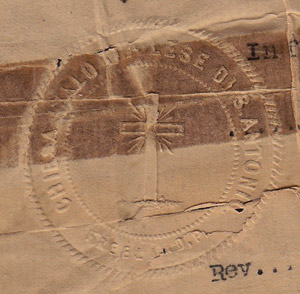 See
further below on this page for the 1902 baptismal certificate of
Ida Moretti, an example of church documents in St. Anthony's earliest
years.
See
further below on this page for the 1902 baptismal certificate of
Ida Moretti, an example of church documents in St. Anthony's earliest
years.Land for St. Anthony's cemetery was purchased in 1905. Before this cemetery opened, burials were made at St. Ann’s cemetery in Woodside. During the time of Father Noviello (post-1958), the cemetery was extended and all plots were identified.
In 1906 a church bell from the Hazleton Lutheran church was brought over by Frank Clauser and Peter Magagna in Clauser’s horse-drawn wagon. The rectory was built in 1911.
There were two non-church organizations created that drew membership from St. Anthony’s: the Sons of Italy and the St. Vigilio Society. See further below for the Sons of Italy, and see the page on Ribbons/Badges of Religious Organizations for the St. Vigilio Society, a Tyrolean mutual aid society.
Also, around 1917, some members of another ethnic group joined St. Anthony’s: these were Magyars, including Kruppa, Bruger, Kauker and others who found St. Anthony's to be the most compatible choice for their church.
Renovations in 1921
Here are three more postcard views of St. Anthony's in its first couple of decades. The leftmost one is from the same period as the black and white postcard above showing the three churches on upper Fern Street. It is as close as I have to a photo of what the Zion Welsh Baptist Church may have looked like. I don't know why it says "St. Januarius R. C. Church", but it's St. Anthony's, and you can see part of St. Mary's old church building next to it. In the center are a color postcard of those three Fern Street churches from Charlie Gallagher, with a crop highlighting St. Anthony's. Note that the label on the color postcard has got the names backwards! St. Anthony's is the church closest to the viewer, the other two being the older and newer St. Mary's church buildings - some renovations had been done to the old St. Mary's since the black and white photo above was taken. And at right is a photo from the Diamond Anniversary commemorative booklet (p. 5) dated 1921, the year of the renovations.
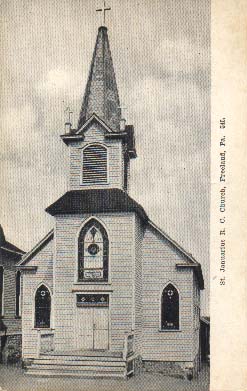

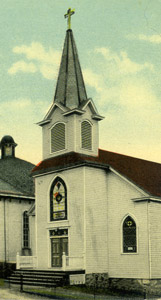

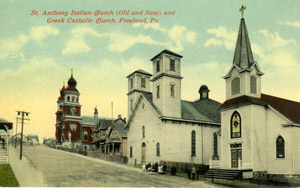

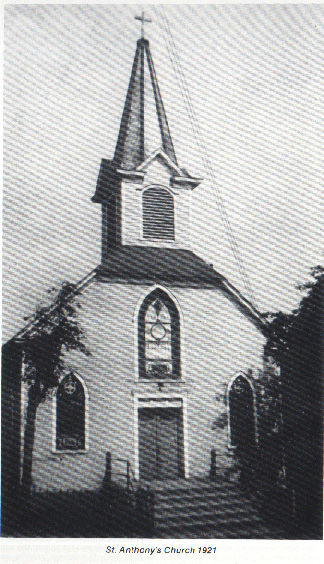

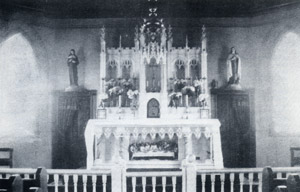 In 1921 major work was done on the church
building, lengthening it to
create a more spacious sanctuary, improving the front of the church,
and adding social rooms. The interior was decorated by
parishioner Arcangelo Pignatari at this time, and a new altar was
donated by Leonard Branz and is shown at left from the 75th anniversary
booklet (p. 8). The cornerstone includes both the
1901 founding date and the 1921 renovation date.
In 1921 major work was done on the church
building, lengthening it to
create a more spacious sanctuary, improving the front of the church,
and adding social rooms. The interior was decorated by
parishioner Arcangelo Pignatari at this time, and a new altar was
donated by Leonard Branz and is shown at left from the 75th anniversary
booklet (p. 8). The cornerstone includes both the
1901 founding date and the 1921 renovation date.Around 1925, a group of Lithuanians who had left St. Casimir’s were welcomed by St. Anthony's and given permission to hold their services in the church basement. The group included Kaminsky, Verbitsky, Kuklis, Kubilus, Martonis, Zelinsky and others. Please see further below for more information about them and for two extraordinary photos from Tom Yaruso showing a Lithuanian wedding and the Lithuanian Peoples Choir, both photos taken at St. Anthony's in the 1920s.
Rebuilding in 1940
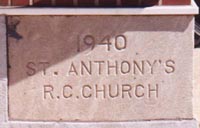
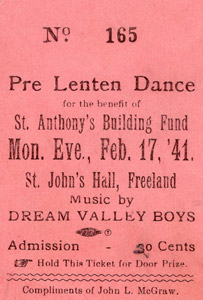 In 1940 a
completely new church was constructed of brick and steel,
wider and longer than the old wooden building to allow for three
aisles and a larger sanctuary. A new cornerstone was also added. Masses
were offered at nearby St. Mary’s
during this 1940-1941 construction period, until the new building was
finished in February 1941. New stained glass windows were made, and new
pews were built by residents of St. Michael’s School for Boys (the 75
anniversary booklet says this was in Pittston, but in my copy that is
crossed out and “White’s-Ferry” is written in the margin – might this
have been the
school in Tunkhannock?). The ticket at right comes from Billy Kuklis
and was for a benefit dance held at St. John's Hall at Ridge and
Luzerne for the benefit of St. Anthony's building fund. The masses at
St. Mary's and the dance(s) at St. John's are good examples of mutual
support among local churches at this time.
In 1940 a
completely new church was constructed of brick and steel,
wider and longer than the old wooden building to allow for three
aisles and a larger sanctuary. A new cornerstone was also added. Masses
were offered at nearby St. Mary’s
during this 1940-1941 construction period, until the new building was
finished in February 1941. New stained glass windows were made, and new
pews were built by residents of St. Michael’s School for Boys (the 75
anniversary booklet says this was in Pittston, but in my copy that is
crossed out and “White’s-Ferry” is written in the margin – might this
have been the
school in Tunkhannock?). The ticket at right comes from Billy Kuklis
and was for a benefit dance held at St. John's Hall at Ridge and
Luzerne for the benefit of St. Anthony's building fund. The masses at
St. Mary's and the dance(s) at St. John's are good examples of mutual
support among local churches at this time.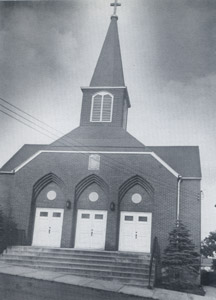

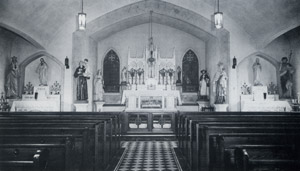 These
two photos come from the Diamond Anniversary booklet (p. 11) and show
the new 1940 building and its lovely interior.
These
two photos come from the Diamond Anniversary booklet (p. 11) and show
the new 1940 building and its lovely interior. Renovations in 1967
In 1966-1967, a new rectory was built next to the church, and the church was renovated, including the construction of a new front. The tower was replaced and extensive work was done on the interior of the church, including carpeting and new stations of the cross. A new altar was donated by Clarence Da Grosa. The basement was also renovated. These photos were taken around 2001 and show that the 1967 renovations had held up well over the years.
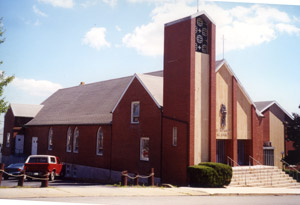

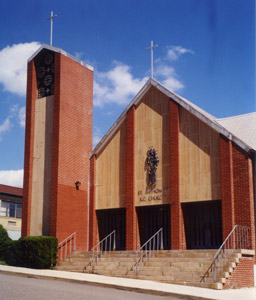

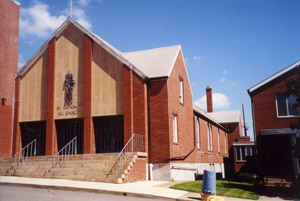

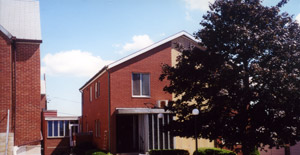
Closing after nearly a century
St. Anthony's was closed approximately a century after its founding, and its parishioners joined the Freeland Roman Catholic Community, later to become part of the new Our Lady of the Immaculate Conception parish which combined the parishes of St. Ann's, St. Anthony's, St. Casimir's, and St. John Nepomucene churches. That faith community is centered at what was formerly St. Ann's Church in the 800 block of Centre Street.
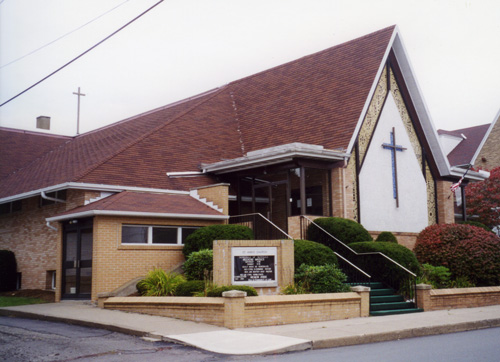

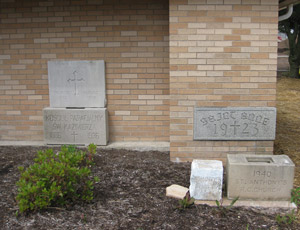
The St. Anthony's cornerstones that I have seen are shown here:
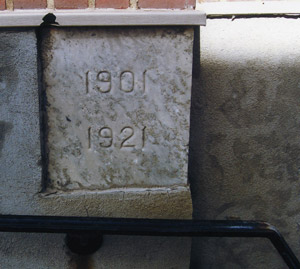




1902 Baptismal certificate for Ida Raffaela Adeline Moretti from St. Anthony’s
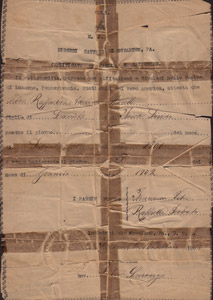
 From
Robert DiGia: My
Great-grandparents were Daniel Moretti and Fosca
DeVido (Moretti). It was normal for the mother to designate their
maiden name. This document shows the spelling as Divido, but other
family documents show it as DeVido. Her full name Enrica Fosca DeVido
Moretti. I am not sure about the correctness of the godparents’ names.
From
Robert DiGia: My
Great-grandparents were Daniel Moretti and Fosca
DeVido (Moretti). It was normal for the mother to designate their
maiden name. This document shows the spelling as Divido, but other
family documents show it as DeVido. Her full name Enrica Fosca DeVido
Moretti. I am not sure about the correctness of the godparents’ names.A little family history to give some life to the document: My Great-grandparents immigrated to the USA in 1894 from a small town on the Adriatic Coast, Pedaso, in the Marche Region of Italy. They moved in with her older sister, and then settled in the Hazelton area in Tomhicken and Drifton. He worked in the mines as a mason. They moved to Western Pennsylvania within a couple years after this baptismal record was secured. He began working for one of the largest tin mills in the USA as division manager until 1938. Four of their children were born in Luzerne County.
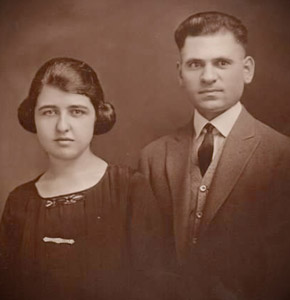 My grandmother, whose
baptism
certificate this is, lived
until 1984. She married in 1922 and had
three children, including one who died at childbirth. Here is a picture
of her and my Grandfather, Ida and Giocondo.
My grandmother, whose
baptism
certificate this is, lived
until 1984. She married in 1922 and had
three children, including one who died at childbirth. Here is a picture
of her and my Grandfather, Ida and Giocondo. 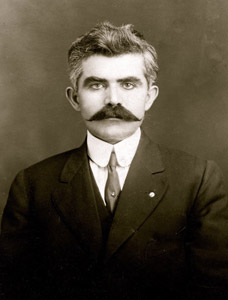 I reviewed the
pictures you had posted [of men and boys at St. Anthony's, see
section below], but did not
recognize my
Great-grandfather. Here is a picture of him in
the early 1900’s.
I reviewed the
pictures you had posted [of men and boys at St. Anthony's, see
section below], but did not
recognize my
Great-grandfather. Here is a picture of him in
the early 1900’s.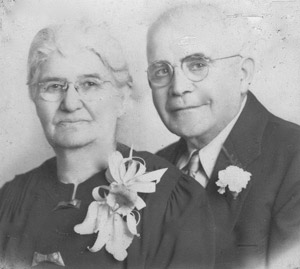 And here is
a photo of my Great-grandparents taken on their 50th wedding
anniversary.
And here is
a photo of my Great-grandparents taken on their 50th wedding
anniversary. Luzerne County was a stepping stone to many families from Northern Italy as they made their way to other parts of the country, mostly to the steel mills of Western Pa. The Morie’s (other spelling Mori), Minardi’s, Agostino’s, DeVido’s, and Moretti’s passed through this county. All were from Adriatic Coastal Areas from Veneto south to the Marche.
Thank you, Robert DiGia, for sharing your family story with us here.
Men and Boys at St. Anthony's, and the Sons of Italy
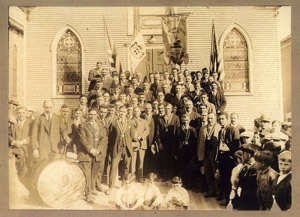

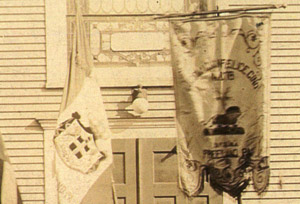 This photograph comes to us from Bob Zimmerman and
shows a large group
of men and boys in front of St.
Anthony's Church in the early 1900s. I've also enlarged
several crops below so that closer views of faces can be seen. Do you
recognize anyone from your family photos? Please let me know. A few
people have written to suggest these identifications:
This photograph comes to us from Bob Zimmerman and
shows a large group
of men and boys in front of St.
Anthony's Church in the early 1900s. I've also enlarged
several crops below so that closer views of faces can be seen. Do you
recognize anyone from your family photos? Please let me know. A few
people have written to suggest these identifications:From Jim DiSpirito: The cropped photo, middle one - The man 5th from left is my great uncle Pasquale DiSpirito, the one holding his hat in front of him with both hands. He was co-owner of DiSpirito's feed mill, they called him Patsy. My uncle Packy says the man on the extreme right with the curly hair and dark complexion is Vito Poleri. Poleri’s owned a construction business on Ridge St.
From Kim Cuoco: This gentleman to the immediate right of the drum with the dark slicked back hair in my husband’s great grandfather Girardo Benicaso, Sr. of Freeland. They had 13 children and only 2 are left to this day one is 87, one 97.
From the late Ricardo Quinones (who died in 2019): … I'm convinced that the photograph of the one man on the right side wearing a panama hat is that of my father. That's him alright! … I don’t know what mine my grandfather worked in. But, I do know that my father is connected to Jeddo. … What attracted Anthony Marthacino from his native Abruzzi to Freeland which was already well populated with Irish and Slovak migrants?
The man you are concerned about is the one you indicated from the right of the picture from the church who is my father wearing a Panamanian straw hat. But my son, Sam and others say the man is too heavy set to be my father. Incidently, my father lived in Jeddo where he briefly worked in the mines.
This may establish a telling detail: my father had a scar over the bridge of his nose which in winter time would turn blue. I think I see elements of that scar on the enlarged photo that you sent.
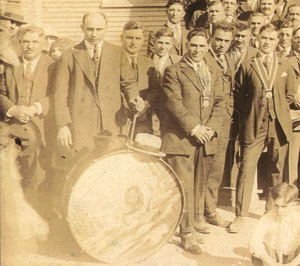

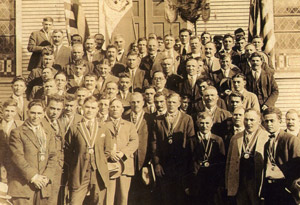

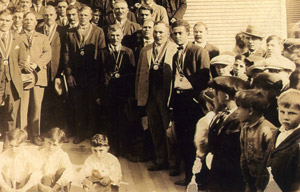
The banner with the lion on it shown in this photo was made around 1921 for the Freeland lodge #878 of the Sons of Italy in America, Loggia Gianfelice Gino No. 878.
Lithuanian Peoples
Choir and a Lithuanian wedding at St. Anthony's, from Tom Yaruso
Both of these photos were taken
in the basement of St. Anthony's
Church, where Lithuanians who left St. Casimir's Church were invited to
hold their services while they decided what to do next - make a new
church or join St. Anthony's parish. Apparently they were
considering
founding a new church in Freeland called St.
Mary's Lithuanian Roman Catholic Church, as there was a listing for
it in the 1928-1929 city directory, with an office located upstairs in
the Seitzinger building at 608 Centre Street. However, as it turned
out, instead the
decision was made to join St. Anthony's parish, responding to a
generous invitation from Rev. Francis P. Bitetti. Some of the
other Lithuanian Freelanders went instead to Sts. Peter & Paul's
Lithuanian Church in Hazleton, but many joined St. Anthony's.So these two photos from Tom Yaruso are from those few years when they had left St. Casimir's but the decision on what to do next had not yet been made. The basement of St. Anthony's was a temporary "home" for these Roman Catholics.
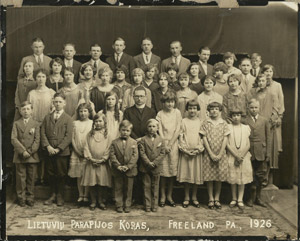 Lietuviu
Parapijos Koras - Tom wrote: This
is
a picture of the "Lithuanian
Peoples Choir, taken in the basement of St. Anthony's Church 1926 just
after Lithuanians broke away from St. Casimir's Polish Church, and
services were held in the basement of St. Anthony's Church. Third row
from top, third girl from left is my aunt Verna Martonis, and fourth
girl is my aunt Mary Martonis from Highland. I hope some family members
[or others] can pick out their parents or grandparents. What a
wonderful photo! There are 40 men, women and children shown here, along
with the priest, possibly Rev. Simon J. Struckus. I wish we could hear
what this choir sang in Lithuanian!
Lietuviu
Parapijos Koras - Tom wrote: This
is
a picture of the "Lithuanian
Peoples Choir, taken in the basement of St. Anthony's Church 1926 just
after Lithuanians broke away from St. Casimir's Polish Church, and
services were held in the basement of St. Anthony's Church. Third row
from top, third girl from left is my aunt Verna Martonis, and fourth
girl is my aunt Mary Martonis from Highland. I hope some family members
[or others] can pick out their parents or grandparents. What a
wonderful photo! There are 40 men, women and children shown here, along
with the priest, possibly Rev. Simon J. Struckus. I wish we could hear
what this choir sang in Lithuanian!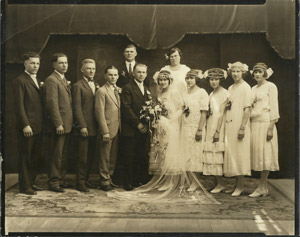 The
second photo shows members of a Lithuanian
wedding, again photographed
in the basement of St. Anthony's Church. Tom wrote: My aunt Verna
Martonis from Highland is second girl from right. Can anyone tell me
the name of the bride and groom? I would say late 1920s.
The
second photo shows members of a Lithuanian
wedding, again photographed
in the basement of St. Anthony's Church. Tom wrote: My aunt Verna
Martonis from Highland is second girl from right. Can anyone tell me
the name of the bride and groom? I would say late 1920s. I really like the headpieces that the women are wearing. Everyone looks so dignified and well-posed. Wonder who the photographer was?
Joan Vanderlick Chisholm wrote: I think I know 4 people in the Lithuanian Choir photo ... In the same row w/the priest, on the left side, 2nd boy is Anthony (Tony) Ravutsky; next to him (1st girl in that row) is my mother, Millicent Yenalevich Vanderlick; the young lady on the priest's left is Millie (married name Ravutsky, Victor's wife); in the 2nd row from the top on the right side, 2nd man is Victor Ravutsky (married to Millie, brother of Anthony). The Ravutsky and Yenalevich families were cousins - their mothers were sisters. Since I don't have a picture of my mother really young, I compared the photo with one of her in her teens and I'm pretty sure it's her. Thanks so much for posting these pictures - I could spend hours going thru Freeland history. It's so interesting and so unbelievably connected.
I've added higher-resolution crops of both photos for better close-up views of the faces. DO YOU RECOGNIZE ANYONE from your own family photos? If so, please let me know and I'll post the information or guesses here. Please help us all to learn more about this part of Freeland's past. Thank you to Tom Yaruso for sharing these photos here.
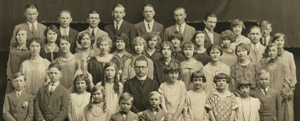

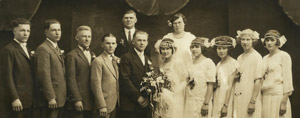
And, here is another photo that Tom Yaruso shared, added on this page because it was taken when these Lithuanians were still part of St. Casimir's.
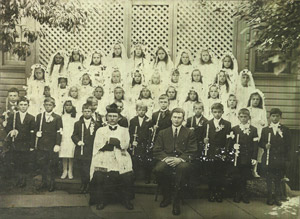 St.
Casimir's Communion class 1914, from Tom Yaruso: "Nice picture
of St. Casimir's Communion Class 1914, Freeland. My aunt Verna Martonis
from Highland is 5th girl from left, top row. Wonder how many people
will know their old family members by looking at this picture?" Tom
later added: "The priest is Father Inczara. The date on the
picture is August, 2 1914."
St.
Casimir's Communion class 1914, from Tom Yaruso: "Nice picture
of St. Casimir's Communion Class 1914, Freeland. My aunt Verna Martonis
from Highland is 5th girl from left, top row. Wonder how many people
will know their old family members by looking at this picture?" Tom
later added: "The priest is Father Inczara. The date on the
picture is August, 2 1914."Thank you to all who have shared information and images, including Charlie Stumpf, Bob Zimmerman, Charlie Gallagher, Billy Kuklis, Robert DiGia, Jim Etheredge, Tom Yaruso, Joan Vanderlick Chisholm.